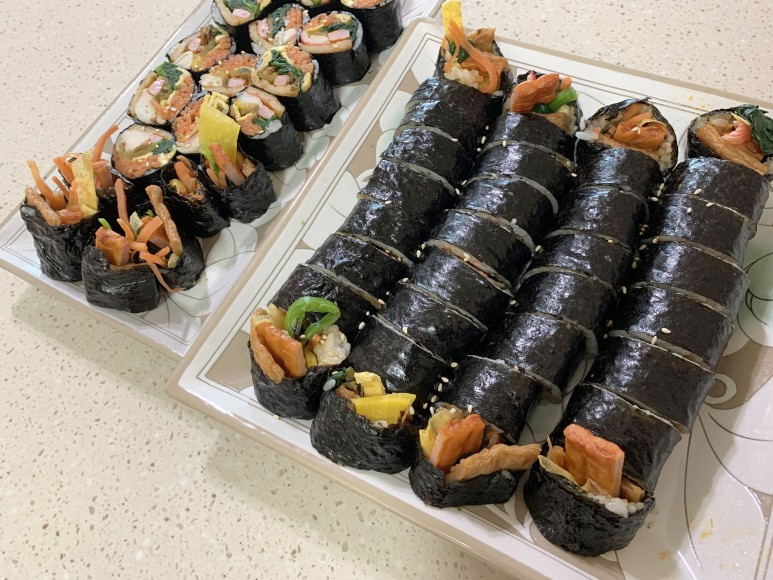Gimbap with Anchovies, Peppers, and Fish Cakes: A Hearty Homemade Delight
#HomemadeGimbap #DIYGimbap #GimbapRecipe #AnchovyPepperGimbap #FishCakeGimbap #CarrotGimbap #RiceLessGimbapRoll

I decided to make homemade gimbap (Korean seaweed rice rolls) after a long time. The beauty of homemade gimbap lies in its simplicity, using common ingredients you likely already have. This time, I put a personal spin on it by incorporating my favorite elements: stir-fried anchovies and spicy peppers, creating a delightful ‘Gochujang Myeolchi Gimbap’ (Gimbap with chili-paste anchovies). For those who prefer a milder heat, I’ve also included ‘Mepjjiri,’ a milder version of the anchovy stir-fry, making it accessible for everyone. Additionally, I made ‘Bap Eomneun Gim Mari’ (rice-less seaweed rolls) using only the gimbap fillings, perfect for using up any leftover ingredients. These rolls are fantastic pan-fried with an egg coating – a truly delicious way to enjoy any leftovers!
Gimbap Ingredients- 2 Carrots
- 1 tsp Salt (for stir-frying carrots)
- 120g Gimbap Ham
- 5 sheets of flat fish cakes
- 2 Tbsp Soy sauce (for braising fish cakes)
- 1 Tbsp Sugar (for braising fish cakes)
- 2 Tbsp Water (for braising fish cakes)
- 2 Eggs
- 1 pinch Salt (for egg wash)
- 4 sticks Imitation crab meat (Crab stick)
- 100g Seasoned Spinach (store-bought or homemade)
- Pickled radish (as needed)
- Cheongyang chili peppers or ‘Mepjjiri’ (mild chili paste anchovy stir-fry) (as needed)
- Gochujang stir-fried anchovies (store-bought or homemade) (as needed)
- 2 bowls Cooked rice
- 1 tsp Sesame oil (for seasoning rice)
- 1 tsp Fried rice seasoning powder (optional, for rice seasoning)
- Gimbap seaweed sheets (4-5 sheets)
Cooking Instructions
Step 1
First, thinly julienne the carrots. Heat a pan with a little cooking oil, add the carrots and 1 tsp of salt, and stir-fry. Cook just until the carrots are slightly softened but still retain a bit of crispness – this is key to maintaining a pleasant texture. Be careful not to overcook them, or they’ll become mushy.

Step 2
Slice the gimbap ham into desired pieces and pan-fry in a little oil until golden brown. This will render some of the fat and enhance its savory flavor.

Step 3
Crack the eggs into a bowl, add a pinch of salt, and whisk well. Pour a thin layer of the egg mixture into a heated pan and cook like a crepe. Once both sides are lightly golden, let it cool slightly before slicing into thin strips for the gimbap.

Step 4
Slice the flat fish cakes into wide, manageable pieces. In a pan, combine the sliced fish cakes with 2 Tbsp soy sauce, 1 Tbsp sugar, and 2 Tbsp water. Braise over medium-low heat until the liquid has reduced and the fish cakes are well-coated with the sauce.

Step 5
Your gimbap fillings are almost ready! Arrange the stir-fried carrots, shredded imitation crab meat, pan-fried ham, and egg strips attractively on a plate.

Step 6
Prepare the braised fish cakes, seasoned spinach, and pickled radish. The pickled radish in the photo was cut into half-moons, and the spinach was store-bought. Feel free to use homemade.

Step 7
Prepare the star ingredients for your ‘Myeolchu Gimbap’: the gochujang stir-fried anchovies and ‘Mepjjiri’ (a milder version). These flavorful additions will elevate your gimbap. I’m using some I had prepared earlier as a side dish.

Step 8
While the rice is still warm, mix in 1 tsp of sesame oil and 1 tsp of fried rice seasoning powder (optional) for seasoning. The seasoning powder adds a savory depth without needing extra salt.

Step 9
Place a sheet of gimbap seaweed on a bamboo mat. Spread about 2/3 of the rice thinly and evenly over the seaweed, leaving a small border at the top. Spreading the rice thinly is crucial to prevent the gimbap from breaking when rolled.

Step 10
Now, carefully arrange your prepared fillings over the rice. Layer the carrots, ham, fish cakes, imitation crab, egg strips, spinach, pickled radish, anchovy stir-fry, and ‘Mepjjiri’ as desired! To roll, lift the edge of the mat and fillings, tucking them in tightly as you roll forward. Press firmly as you go to create a compact roll that won’t unravel.

Step 11
Voila! Your beautifully rolled homemade gimbap is ready. I didn’t add a lot of carrots this time because a family member isn’t a big fan, but I personally love them and will add even more next time!

Step 12
Now, let’s make the rice-less ‘Gim Mari.’ Spread a very thin layer of rice on the seaweed sheet, just enough to act as a binder at the edge. Then, add generous amounts of your chosen fillings like carrots, egg strips, ham, and fish cakes. Roll it up tightly, similar to the regular gimbap. Importantly, avoid adding strongly flavored ingredients like salty anchovy stir-fry or spicy peppers to the rice-less rolls, to better appreciate the natural flavors of the other fillings.

Step 13
And there you have it! The rice-less Gim Mari and the classic homemade gimbap are complete. The one shown with its cross-section visible on the serving plate is the rice-less roll, while the neatly stacked ones are the traditional rice-filled gimbap. Any leftover rice-less rolls can be dipped in egg wash and pan-fried for an extra delicious treat! ^^




